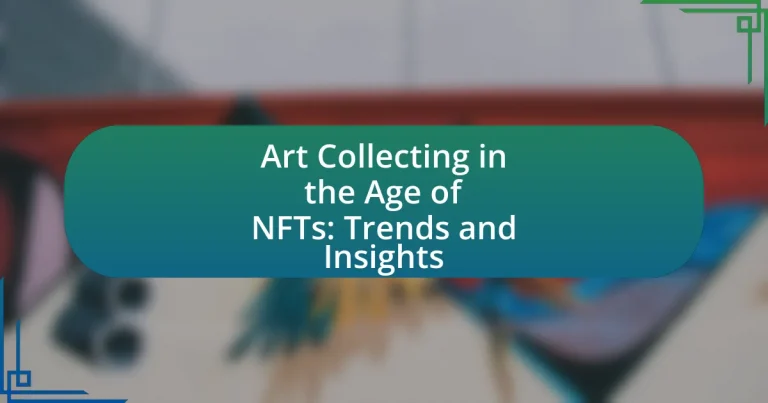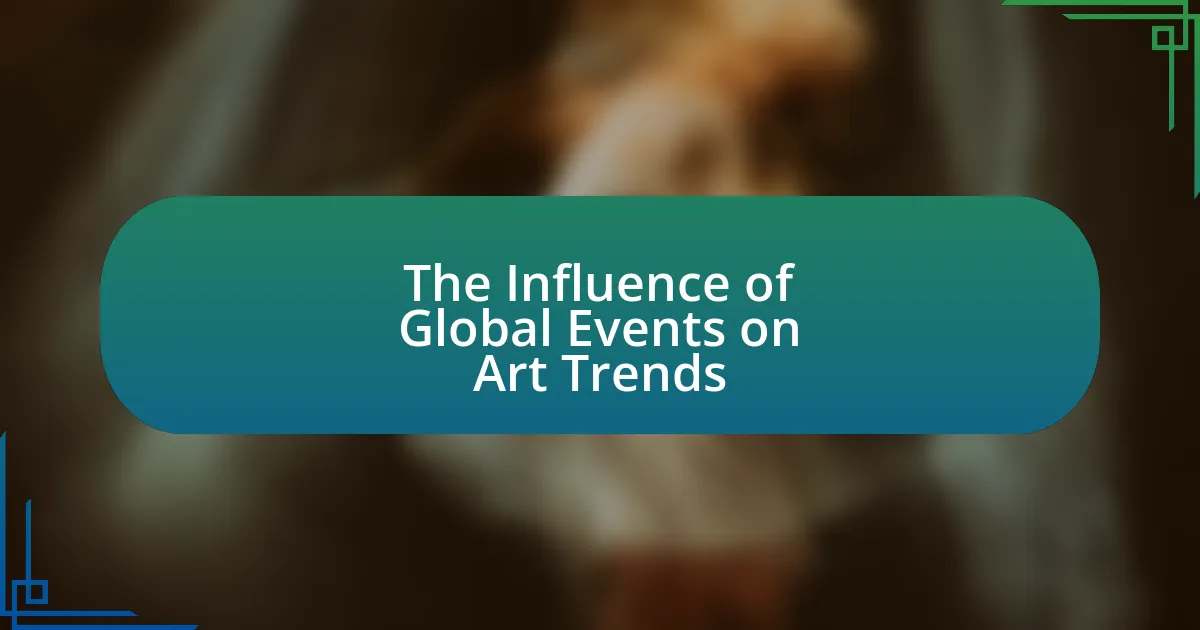Art collecting in the age of NFTs involves the acquisition of digital artworks represented as non-fungible tokens, which provide proof of authenticity and ownership through blockchain technology. This article explores the evolution of art collecting with NFTs, highlighting key trends such as increased accessibility, the rise of digital ownership, and the adaptation of traditional collectors to the NFT market. It also examines the unique benefits NFTs offer, including verifiable ownership and provenance tracking, while addressing challenges like market volatility and legal considerations. Additionally, the article discusses the impact of social media and online communities on NFT art collecting, providing insights into best practices for collectors in this rapidly evolving landscape.
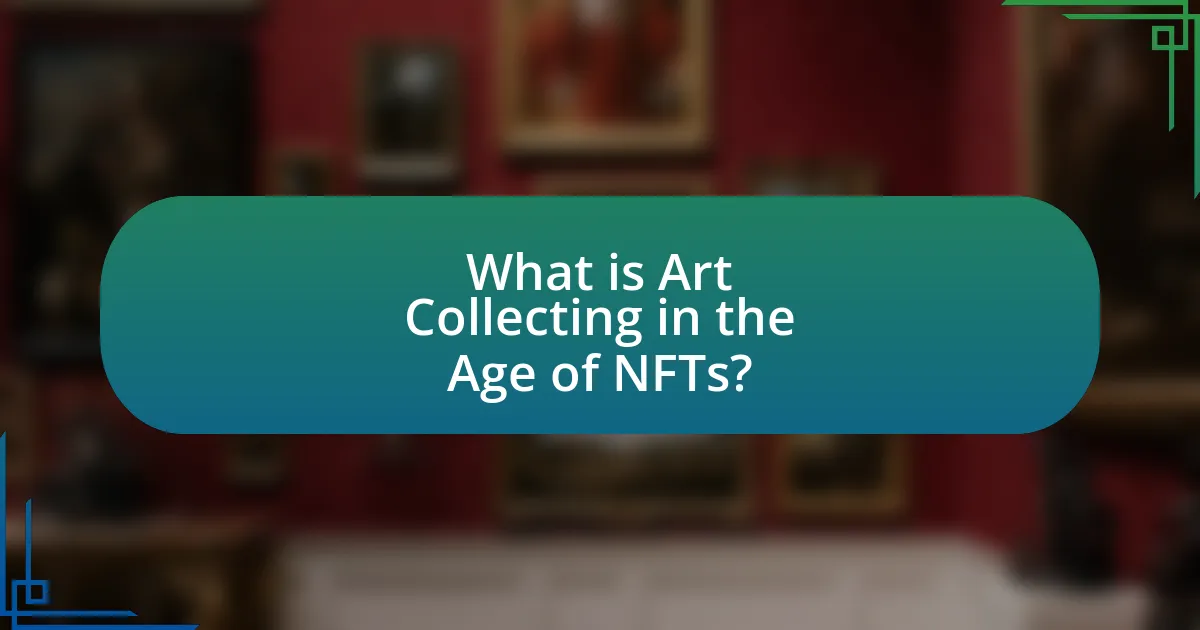
What is Art Collecting in the Age of NFTs?
Art collecting in the age of NFTs refers to the acquisition and ownership of digital artworks represented as non-fungible tokens, which provide proof of authenticity and ownership on a blockchain. This new form of collecting has transformed traditional art markets by enabling artists to sell their work directly to collectors without intermediaries, thus increasing accessibility and democratizing the art world. According to a report by Art Basel and UBS, the global art market reached $65.1 billion in 2021, with a significant portion attributed to digital art sales, highlighting the growing importance of NFTs in contemporary art collecting.
How has the concept of art collecting evolved with the introduction of NFTs?
The concept of art collecting has evolved significantly with the introduction of NFTs, as they provide a new digital medium for ownership and provenance. Traditional art collecting focused on physical artworks, but NFTs allow collectors to own unique digital assets verified through blockchain technology, which ensures authenticity and scarcity. This shift has expanded the art market, enabling artists to reach global audiences and collectors to invest in digital art forms, such as virtual reality pieces and digital illustrations. According to a report by Art Basel and UBS, the NFT market reached $2.6 billion in sales in the first half of 2021 alone, highlighting the rapid growth and acceptance of digital art collecting.
What are NFTs and how do they relate to digital art?
NFTs, or Non-Fungible Tokens, are unique digital assets verified using blockchain technology, which ensures their authenticity and ownership. They relate to digital art by providing a mechanism for artists to sell their work as verifiable, one-of-a-kind items, allowing for ownership transfer and provenance tracking. The rise of NFTs has transformed the digital art market, with sales reaching over $2.5 billion in the first quarter of 2021 alone, demonstrating their significant impact on art collecting and valuation.
How do NFTs change the ownership and provenance of art?
NFTs fundamentally alter the ownership and provenance of art by providing a secure, verifiable digital record of ownership on the blockchain. This technology ensures that each piece of art is linked to a unique token that confirms its authenticity and ownership history, making it nearly impossible to forge or duplicate. For instance, the sale of Beeple’s “Everydays: The First 5000 Days” for $69 million in 2021 exemplifies how NFTs can establish provenance, as the blockchain records every transaction associated with the artwork, allowing buyers to trace its history back to the original creator. This transparency enhances trust among collectors and artists, as it mitigates issues related to forgery and misattribution, thereby revolutionizing the art market.
What are the key trends in art collecting influenced by NFTs?
Key trends in art collecting influenced by NFTs include the rise of digital ownership, increased accessibility to a global market, and the emergence of new revenue streams for artists. Digital ownership is established through blockchain technology, allowing collectors to verify authenticity and provenance of artworks. This has led to a significant increase in participation from younger collectors who are more comfortable with digital assets. Additionally, NFTs have democratized access to art, enabling collectors from diverse backgrounds to engage with artists directly, often through platforms that facilitate sales without traditional gatekeepers. Furthermore, artists are now able to earn royalties on secondary sales, creating ongoing revenue opportunities that were not possible in traditional art markets. These trends reflect a transformative shift in how art is created, bought, and sold in the digital age.
How are traditional art collectors adapting to the NFT market?
Traditional art collectors are increasingly embracing the NFT market by diversifying their portfolios to include digital assets. This adaptation is evident as many collectors are purchasing NFTs to complement their physical art collections, recognizing the growing legitimacy and value of digital art. For instance, a report by Art Basel and UBS in 2021 indicated that 25% of collectors surveyed had purchased NFTs, highlighting a significant shift in collecting behavior. Additionally, traditional galleries are beginning to showcase NFTs alongside physical artworks, further bridging the gap between the two markets. This trend demonstrates that traditional art collectors are not only investing in NFTs but are also actively seeking ways to integrate them into their established collecting practices.
What new demographics are entering the art collecting space due to NFTs?
Younger generations, particularly Millennials and Gen Z, are entering the art collecting space due to NFTs. This demographic shift is driven by their familiarity with digital technology and online platforms, which facilitate the purchase and trade of digital art. According to a report by Art Basel and UBS, 63% of collectors under 40 are now engaging with NFTs, highlighting a significant trend towards digital assets in the art market. Additionally, the accessibility of NFTs allows individuals with lower financial barriers to participate in art collecting, further diversifying the demographic landscape.
Why is the NFT art market gaining popularity among collectors?
The NFT art market is gaining popularity among collectors due to its unique ability to provide verifiable ownership and provenance of digital art. This shift is driven by the increasing acceptance of blockchain technology, which ensures that each NFT is a one-of-a-kind asset that cannot be duplicated, thus enhancing its value. According to a report by NonFungible.com, the NFT market saw a staggering growth of over 300% in 2021, with sales reaching approximately $2.5 billion, indicating a strong demand among collectors. Additionally, the appeal of supporting artists directly and the potential for investment returns further contribute to the market’s rise in popularity.
What unique benefits do NFTs offer to art collectors?
NFTs offer art collectors unique benefits such as verifiable ownership, provenance tracking, and the potential for royalties on secondary sales. Verifiable ownership is ensured through blockchain technology, which provides a secure and immutable record of ownership that cannot be altered or forged. Provenance tracking allows collectors to trace the history of an artwork, confirming its authenticity and previous ownership, which enhances its value. Additionally, many NFTs are programmed to include smart contracts that enable artists to receive a percentage of sales whenever their work is resold, creating ongoing revenue streams for creators and incentivizing collectors to support artists. These features collectively enhance the art collecting experience by providing transparency, security, and financial benefits.
How does the scarcity of NFTs impact their value in the art market?
The scarcity of NFTs significantly increases their value in the art market. This phenomenon occurs because limited availability creates a sense of exclusivity and desirability among collectors and investors. For instance, when an artist releases a finite number of NFTs for a particular artwork, the rarity drives demand, often leading to higher prices. A notable example is the sale of Beeple’s “Everydays: The First 5000 Days,” which sold for $69 million, highlighting how scarcity can elevate perceived value. Additionally, market dynamics indicate that as more collectors seek unique digital assets, the scarcity of NFTs becomes a critical factor in determining their market price.
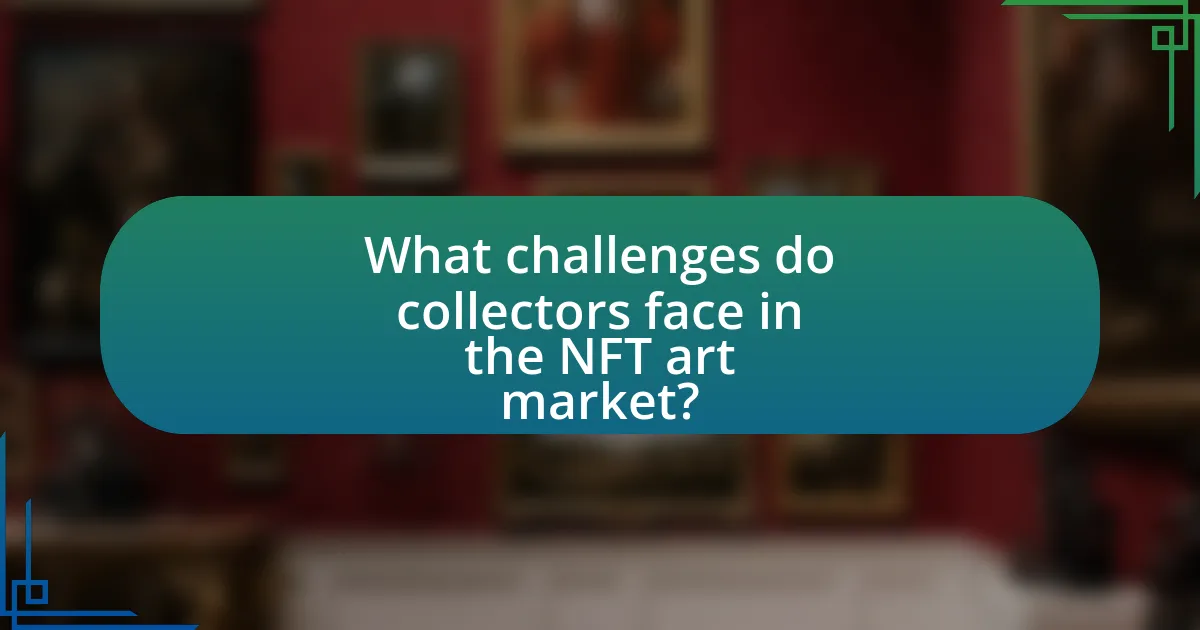
What challenges do collectors face in the NFT art market?
Collectors in the NFT art market face several challenges, including market volatility, lack of regulation, and issues with authenticity. Market volatility is significant, as the prices of NFTs can fluctuate dramatically, leading to potential financial losses for collectors. According to a report by NonFungible.com, the NFT market experienced a 90% decline in sales volume from its peak in 2021, highlighting the instability.
Additionally, the lack of regulation in the NFT space creates uncertainty regarding ownership rights and intellectual property, making it difficult for collectors to navigate legal issues. Furthermore, verifying the authenticity of digital art can be challenging, as counterfeit NFTs can exist, undermining the value of genuine pieces. These factors collectively complicate the experience for collectors in the NFT art market.
What are the risks associated with investing in NFT art?
Investing in NFT art carries several risks, including market volatility, lack of regulation, and potential for fraud. The NFT market is highly speculative, with prices fluctuating dramatically; for instance, a report from NonFungible.com indicated that the NFT market experienced a 90% decline in sales volume from its peak in 2021. Additionally, the absence of regulatory oversight can lead to issues such as copyright infringement and misrepresentation of ownership. Furthermore, the risk of fraud is significant, as scammers can create counterfeit NFTs or manipulate prices through wash trading. These factors collectively contribute to the uncertainty and potential financial loss associated with investing in NFT art.
How can collectors verify the authenticity of NFT artworks?
Collectors can verify the authenticity of NFT artworks by checking the blockchain ledger where the NFT is recorded. Each NFT is associated with a unique token ID and metadata that are stored on the blockchain, providing a transparent and immutable record of ownership and provenance. By examining the blockchain, collectors can confirm the original creator, transaction history, and current ownership, ensuring that the NFT is genuine and not a counterfeit. This verification process is supported by the decentralized nature of blockchain technology, which prevents unauthorized alterations and maintains a clear chain of custody for each digital asset.
What legal considerations should collectors be aware of when purchasing NFTs?
Collectors should be aware of copyright and intellectual property rights when purchasing NFTs. These legal considerations are crucial because owning an NFT does not automatically grant the buyer ownership of the underlying intellectual property associated with the digital asset. For instance, the creator may retain copyright, which allows them to control how the artwork is used, reproduced, or displayed. Additionally, collectors should consider the terms of service of the NFT marketplace, as these can dictate the rights and responsibilities of both buyers and sellers. Legal disputes can arise if the terms are not clearly understood, leading to potential financial loss or infringement claims. Therefore, understanding these legal frameworks is essential for collectors to protect their investments and ensure compliance with applicable laws.
How does the volatility of the NFT market affect art collecting?
The volatility of the NFT market significantly impacts art collecting by creating an unpredictable environment for both buyers and sellers. This unpredictability can lead to rapid price fluctuations, which may deter traditional art collectors who prefer stable investments. For instance, a study by NonFungible.com reported that the NFT market experienced a 90% decline in sales volume from its peak in 2021, illustrating the potential for drastic changes in value. Consequently, art collectors may approach NFT investments with caution, focusing on established artists or projects with a proven track record to mitigate risks associated with market instability.
What strategies can collectors use to mitigate risks in a fluctuating market?
Collectors can mitigate risks in a fluctuating market by diversifying their portfolios across various types of art and collectibles. This strategy reduces the impact of market volatility on any single asset class, as different segments may respond differently to economic changes. For instance, during economic downturns, traditional art may hold value better than digital art or NFTs, as evidenced by historical trends where blue-chip artworks have consistently appreciated over time, even in recessions. Additionally, collectors can conduct thorough market research and stay informed about trends, which allows them to make educated decisions about acquisitions and sales. Engaging with experts and participating in art fairs can also provide insights into market dynamics, further aiding in risk management.
How can collectors assess the long-term value of NFT art?
Collectors can assess the long-term value of NFT art by analyzing factors such as the artist’s reputation, historical sales data, and the uniqueness of the digital asset. The artist’s track record and recognition in the art community significantly influence the perceived value; for instance, established artists like Beeple have seen their works sell for millions, indicating strong market demand. Historical sales data, including previous auction prices and resale values, provide insights into market trends and potential appreciation over time. Additionally, the uniqueness and rarity of the NFT, often determined by its edition size and the technology behind it, can enhance its value; for example, one-of-a-kind pieces typically command higher prices than those with multiple editions. Collectors should also consider the broader market trends in the NFT space, as fluctuations in cryptocurrency values and changes in consumer interest can impact long-term value.
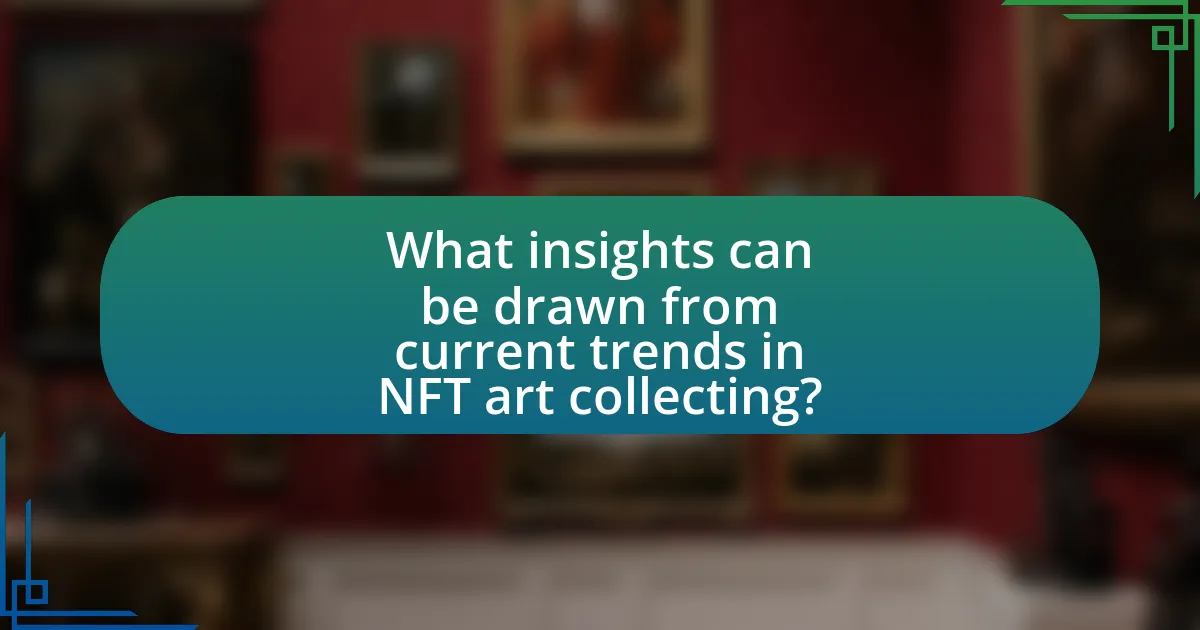
What insights can be drawn from current trends in NFT art collecting?
Current trends in NFT art collecting indicate a significant shift towards digital ownership and community engagement. The rise of platforms like OpenSea and Rarible has facilitated access to a broader audience, with NFT sales reaching over $10 billion in 2021, showcasing the growing market. Additionally, artists are increasingly leveraging NFTs to retain royalties on secondary sales, which enhances their long-term financial sustainability. The trend also highlights a growing interest in environmental concerns, as many collectors are advocating for eco-friendly blockchain solutions. These insights reflect a transformative phase in the art world, where digital assets are becoming integral to contemporary collecting practices.
What are the most popular platforms for buying and selling NFT art?
The most popular platforms for buying and selling NFT art include OpenSea, Rarible, and Foundation. OpenSea is the largest NFT marketplace, facilitating millions of transactions and hosting a vast array of digital art. Rarible allows users to create, buy, and sell NFTs while also incorporating a governance token, RARI, to empower its community. Foundation focuses on curated art, enabling artists to sell their work through a selective process that enhances quality and exclusivity. These platforms have gained prominence due to their user-friendly interfaces, extensive user bases, and innovative features that cater to both artists and collectors.
How do different platforms impact the visibility and sales of NFT artworks?
Different platforms significantly impact the visibility and sales of NFT artworks by influencing audience reach, user engagement, and transaction fees. For instance, platforms like OpenSea and Rarible have large user bases, which enhances the exposure of listed artworks, leading to higher sales potential. In contrast, niche platforms may cater to specific audiences, potentially limiting visibility but fostering a more engaged community. Additionally, transaction fees vary across platforms; lower fees can incentivize more sales, while higher fees may deter buyers. According to a report by NonFungible.com, OpenSea accounted for over 90% of the NFT market share in 2021, illustrating how platform dominance can directly correlate with sales volume.
What role do social media and online communities play in NFT art collecting?
Social media and online communities are crucial in NFT art collecting as they facilitate discovery, engagement, and transactions among collectors and artists. Platforms like Twitter, Discord, and Instagram allow artists to showcase their work, while collectors can share insights and trends, creating a vibrant ecosystem. According to a report by NonFungible.com, over 80% of NFT transactions are influenced by social media interactions, highlighting its impact on market dynamics. Additionally, online communities provide a space for discussions, collaborations, and support, further enhancing the NFT art collecting experience.
What best practices should collectors follow when engaging with NFT art?
Collectors should prioritize thorough research and verification of NFT art before making purchases. Engaging with reputable platforms and artists ensures authenticity and value. According to a report by NonFungible.com, the NFT market reached $10.7 billion in sales in 2021, highlighting the importance of informed decision-making in a rapidly evolving space. Additionally, collectors should consider the long-term potential of the NFT, including the artist’s reputation and market trends, to make sound investments.
How can collectors build a diverse and valuable NFT art collection?
Collectors can build a diverse and valuable NFT art collection by actively researching various artists, styles, and platforms to identify unique pieces that resonate with different audiences. Engaging with the NFT community through social media and forums allows collectors to discover emerging artists and trends, enhancing the diversity of their collection. Additionally, diversifying across different genres, such as digital paintings, generative art, and virtual reality experiences, can increase the overall value of the collection. According to a report by NonFungible.com, the NFT market saw a significant increase in sales volume, indicating a growing interest in diverse digital art forms, which supports the strategy of collecting across various categories.
What resources are available for collectors to stay informed about NFT trends?
Collectors can stay informed about NFT trends through various resources such as dedicated NFT news websites, social media platforms, and community forums. Websites like CoinDesk and NFT Now provide up-to-date news and analysis on NFT markets and trends. Social media platforms, particularly Twitter and Discord, host active discussions and updates from industry leaders and artists. Additionally, platforms like OpenSea and Rarible offer insights into trending collections and sales data, allowing collectors to track market movements effectively. These resources collectively provide a comprehensive view of the evolving NFT landscape, enabling collectors to make informed decisions.
